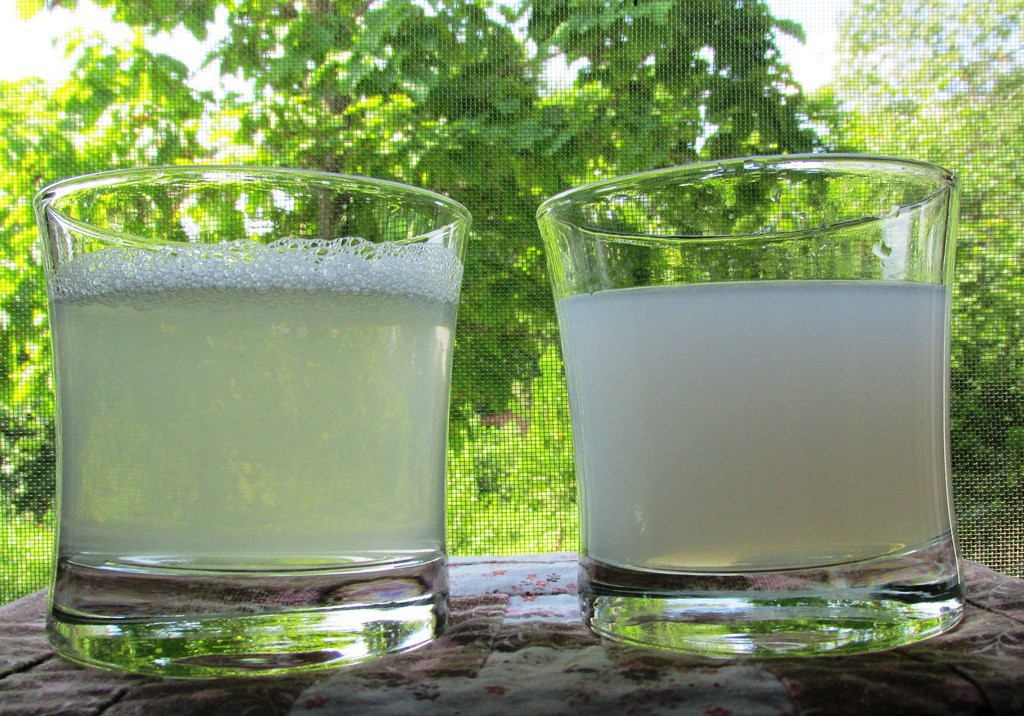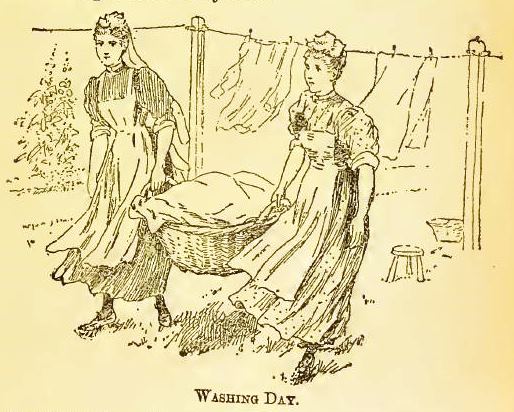
The glass on the left contains sudsy rainwater and is translucent. The glass on the right holds hard well water, remained cloudy, made no suds and formed a soap scum ring.
Back when every home had a rain barrel stationed below the rainspout, our grandmothers knew rainwater was a must for washing hair. Grandma probably even knew why water falling from the sky felt better than that pumped from the ground. Admittedly, I didn’t know the benefits of cleaning with rainwater until going off-grid with my laundry duties.
I learned in my 1909 copy of “Household Discoveries” a simple test for discerning at home whether water is fit for laundry purposes. Simply dissolve a dab of good white soap in rubbing alcohol. Put a few drops of this mixture into a glass of water. “If the water is pure, the soap solution will be dissolved and the water will continue limpid, but if it is impure the soap will form into white flakes which will tend to float on the surface.”
To test this, I used two glasses of water – one from our drilled well and the other from the stock tank below the rain gutter. The soap disappeared immediately in the rainwater, but never dissolved or made suds in the hard water. After an hour, the well water glass also had a scummy ring on top.
For years, I accused my electric washing machine of doing a second-rate job of cleaning our clothes. Who would have thunk it was merely a water issue? Now that I wash with rainwater, our laundry is no longer crispy-crunchy or besmirched and grey.
Before actually going off-grid, I ran a garden hose from the rain tank outside to our electric washing machine in the basement just to see if the machine would launder better. It did, and I no longer had to add borax, washing soda or vinegar to the rinse cycle. While these additives are natural and relatively inexpensive, it is one more step to perform (and remember before the spin cycle ends).
“Household Discoveries” lists several ways to soften water, but also acknowledges that rainwater is absolutely best for cleaning anything, even without soap. In case of drought when a sufficient supply of rainwater cannot be obtained, however, here are some old-time methods for softening water:
“Bring the water to a boil and expose it to the air, which may be done by pouring it from some height into a tub or other vessel, and afterwards letting it stand overnight.
“Or boil it with the addition of a little baking soda, and afterwards expose it to the air.
“Or place a quantity of clean wood ashes in a tightly closed woolen bag and immerse the bag in a tub of water. The required amount of ashes can be ascertained by experiment.
“Or use chalk, which may be put into the spring or well or used in a tub or bucket, the proper amount depending upon the extent of the impurities, and to be determined in each locality by experiment.
“Or add a small quantity of borax or potash or soda lye, but care must be taken not to use too much, as otherwise the alkali they contain will injure the fabrics.
“Or add 1 to 2 tablespoonfuls of quicklime to each tubful of water. Slake the lime with a little warm water, stirring it to a cream, pour it into a tubful or boilerful of water, and let stand overnight or long enough to settle to the bottom. Pour off the clear water, taking care not to disturb the sediment.”
 These water-softening tips make collecting rainwater much more appealing, don’t they?
These water-softening tips make collecting rainwater much more appealing, don’t they?
We do not live in an industrial area or have large tree limbs overhanging our roof, which is metal. As such, we have only an ordinary mesh screen over the rain tank to keep out bugs and other debris. If the roof is asphalt or other airborne contaminants are a concern, the first few gallons of rainwater can be diverted away from the cistern (referred to as first flushing).
Where pollution is heavy, the water can also be filtered. A free-standing drip filter such as the Katadyn Drip Gravadyn can be easily installed in a rainwater harvesting system. And here is information about an old-time rainbarrel filter.
Mother Earth News has many wonderful articles about collecting rainwater. These were useful to us when we set up our “cloud juice” system:
Build a Rainwater Harvesting System
Build a Rainwater Collection System
Harvesting Rainwater: How to Make a Rain Barrel
A Better Rainwater-Harvesting System

Pingback: Off-Grid Laundry Made Easy – Well WaterBoy Products